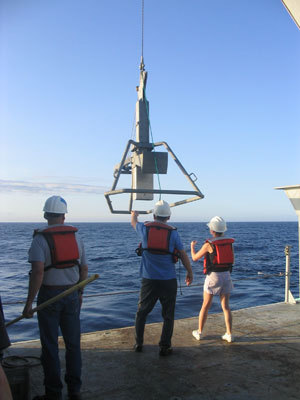| January 24th, Tuesday
Blog entry by Jaqui Neibauer
After what seemed like forever, we finally finished my box coring early this morning. Unfortunately, only one of my last three stations visited produced a sediment core. The seafloor at the other two stations was probably composed of hard substrate, possibly a hardened lava flow. These three stations were about twice as deep as my last three on the West side of
Isabela Island
, so it took a much larger amount of time for the box corer to go to the seafloor and back. It was pretty discouraging that we didn’t recover any sediment from two of the stations…especially since we spent such a long time waiting for them. There is really no way to tell if a core is recovered until the box corer is back on deck, so anticipation always runs high when the box corer gets close to the ocean’s surface. The one core that was retrieved was very interesting, though. It was composed of about three very distinct layers…a dark brown liquidy mud on top, a stickier clay in the middle, and some black coarse grained material (likely volcanic debris).
Kathy Newell found an interesting phytoplankton species in one of the net tows done this morning. It was a chain-forming diatom called Chaetoceros coarctatus. The neat thing about this species is that it is usually colonized by a microzooplankton called Vorticella. The two species coexist in a symbiotic relationship.

Chaetoceros coarctatus
Allison will be taking some sediment cores further south from my last three stations and this core was an indication that she might find what she is looking for. She was pretty excited about this core. Hopefully she will get some good sediment when she cores so that I may analyze her cores, too. We’ll find out in the next couple of days. Allison started her EM300 seafloor mapping survey tonight, which revealed some very interesting features. She was looking for a seafloor channel that runs through the canal between Isabella and
Santiago
Islands
. She found evidence of the channel, but was also surprised to find quite a few small volcanoes poking up out of the seafloor. Her mapping transect is only halfway done and will finish in the morning after our day of “R&R.”
The highlight of tonight for some of us was star-gazing off the upper deck of the ship. All of the deck lights were off since we were just steaming between stations, so the stars looked incredible. It’s hard to even describe the sight. We saw Orion’s Belt, the Southern Cross, lots of shooting stars, Cassiopeia, and the Big Dipper, which was upside-down since we are in the southern hemisphere. At around
3 am
, the moon rose over the horizon. At first, we couldn’t tell what it was because it just looked like a bright red light on a far-away ship. Then it started quickly increasing in size and took on a crescent shape. It continued to rise into the sky, turning to more of a dark yellow color.
We will be going ashore at
James Bay
on
Santiago
Island
tomorrow morning. Supposedly, there is a lot of wildlife to see at this place. We will be going ashore in small groups and will be guided by our naturalist, Byron. It will be nice to be able to visit one of the beautiful islands we have been cruising by the last few days.

Well, this didn't come out of my core - it is a gecko that shared my shower back in Quito.
|

Me (left) and Allison with our funky and fun core.

Our core has a highly oxidized top layer and a typical Pacific hemipelagic middle layer of clay, both overlain above an ash and gravel lava flow layer.

This is me and Roy attempting to get our core eight hours before the image above was taken! It takles a long time to sample the deep sea.
|